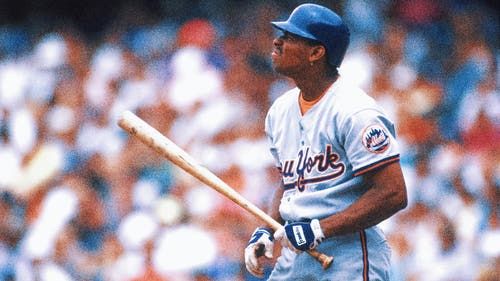
Foreign concept? Here's how a USA vs. World All-Star format could work

I was born after the Miracle on Ice, so I can say this with certainty: I’ve never seen American sports fans invest so deeply in one of our national teams as I did during the World Cup.
Sports patriotism became en vogue in our cynical land. Snark — the native language of social media — went on summer vacation. If you weren’t a fan of Clint Dempsey, Tim Howard and the rest of our guys, you were a social outcast. You’re welcome to call me a flag-waving idealist, but I loved it.
Baseball isn’t soccer, but forgive me for wondering why we can’t carry a sliver of that passion into our next national sports celebration — the Major League Baseball All-Star Game.
The basic structure of the Midsummer Classic — American League vs. National League — has remained the same since its creation in 1933. For much of its history, the All-Star Game’s allure was that it showcased the very best players from two separate leagues. But the AL and NL no longer operate independently, the lines between them blurred further by season-long interleague play and frequent free agency.
Today’s AL players don’t profess an earnest desire to whip the NL, the way Ted Williams might have, in part because a number of them might be playing for the NL by this time next year. A game between Team USA and Team World would do a better job of stirring pride and emotion among superstars on the field — and fans around the globe.
How about Clayton Kershaw, with “USA” emblazoned across his jersey, staring down Dodgers teammate Yasiel Puig?
Or Mike Trout stepping in against Masahiro Tanaka with the game on the line?
Intrigued yet?
This is a good place to acknowledge that my zealotry for international baseball — specifically the World Baseball Classic — is without limit. But the most common criticism of the WBC — incomplete participation among the top American players — wouldn’t apply here. With very few exceptions, major leaguers don’t turn down invitations to the All-Star Game.
In soccer, basketball and hockey, we’ve seen the vast entertainment and marketing appeal of putting America’s best on a single team. Why not baseball, too?
It’s not as if the concept is foreign to our national pastime: The Futures Game, a prospect showcase two days before the All-Star Game, has a USA-versus-the-World format. Philosophically, this isn’t the huge leap it may appear to be.
As a practical matter, the greatest hurdle might be the equitability of competition for All-Star spots. Under the current system, every major leaguer has roughly the same statistical probability of being named to an All-Star team — which often means a contractual bonus and added leverage in future salary negotiations. (Each roster includes 34 players — before injury replacements — for a total of 68.)
The calculus would change if only one All-Star team were available to American-born players. According to MLB figures, foreign-born players accounted for 26.3 percent of Opening Day roster spots this year. Thus, in theory, international players would face less competition to make the All-Star team.
One potential solution would be to create three All-Star teams of 25 players — one World roster and two U.S. teams — for a total of 75 All-Stars. The players’ union would have the benefit of seven additional roster spots, while MLB could turn the All-Star Game into a two-night All-Star showcase, with double the revenues: World vs. USA 1 on Tuesday, World vs. USA 2 on Wednesday.
Even while drawing from a pool that accounts for barely more than one-quarter of the major leagues, the World team would have more than enough star power to compete with the U.S. — particularly with the influx of stars from Cuba and Japan.
Consider, for a moment, how the U.S. and World rosters might look — with more than 25 names included for each to show how much depth exists:
WORLD
C — Yadier Molina, Salvador Perez
1B — Miguel Cabrera, Edwin Encarnacion
2B — Robinson Cano, Jose Altuve
3B — Pablo Sandoval
SS — Alexei Ramirez, Jhonny Peralta
OF — Yasiel Puig, Jose Bautista, Carlos Gomez, Nelson Cruz, Melky Cabrera, Yoenis Cespedes, Gregory Polanco
DH — Jose Abreu, Victor Martinez, David Ortiz
Starters — Felix Hernandez, Yu Darvish, Masahiro Tanaka, Johnny Cueto, Anibal Sanchez, Jose Quintana, Julio Teheran, Hyun-Jin Ryu
Relievers — Francisco Rodriguez, Rafael Soriano, Fernando Rodney, Koji Uehara, Jean Machi, Fernando Abad
USA
C — Jonathan Lucroy, Buster Posey, Kurt Suzuki
1B — Paul Goldschmidt, Freddie Freeman, Anthony Rizzo, Brandon Moss
2B — Ian Kinsler, Dustin Pedroia, Scooter Gennett
3B — Todd Frazier, Josh Donaldson, Kyle Seager, Evan Longoria
SS — Troy Tulowitzki, Brandon Crawford, Derek Jeter (he’s earned his sendoff)
OF — Mike Trout, Giancarlo Stanton, Andrew McCutchen, Alex Gordon, Adam Jones, Jason Heyward, Michael Brantley, Coco Crisp
DH — Adam Dunn
Starters — Clayton Kershaw, David Price, Jon Lester, Adam Wainwright, Garrett Richards, Jordan Zimmermann, Max Scherzer, Phil Hughes, Rick Porcello, Corey Kluber, John Lackey, Madison Bumgarner, Stephen Strasburg, Zack Greinke
Relievers — Greg Holland, Craig Kimbrel, Jake McGee, Will Smith, Luke Gregerson, J.P. Howell, Steve Cishek, Zach Britton, Sean Doolittle, Wade Davis, Jonathan Papelbon
Would a couple nights of baseball prove definitively whether the U.S. remains the lone superpower in our national pastime? No, of course not. But the event might inspire a raucous outdoor watch party or two.










